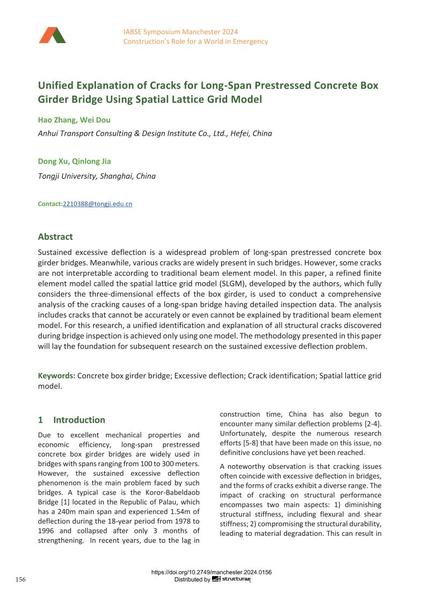Unified Explanation of Cracks for Long-Span Prestressed Concrete Box Girder Bridge Using Spatial Lattice Grid Model

|
|
|||||||||||
Bibliographic Details
| Author(s): |
Hao Zhang
(Anhui Transport Consulting & Design Institute Co., Ltd., Hefei, China)
Wei Dou (Anhui Transport Consulting & Design Institute Co., Ltd., Hefei, China) Dong Xu (Tongji University, Shanghai, China) Qinlong Jia (Tongji University, Shanghai, China) |
||||
|---|---|---|---|---|---|
| Medium: | conference paper | ||||
| Language(s): | English | ||||
| Conference: | IABSE Symposium: Construction’s Role for a World in Emergency, Manchester, United Kingdom, 10-14 April 2024 | ||||
| Published in: | IABSE Symposium Manchester 2024 | ||||
|
|||||
| Page(s): | 156-164 | ||||
| Total no. of pages: | 9 | ||||
| DOI: | 10.2749/manchester.2024.0156 | ||||
| Abstract: |
Sustained excessive deflection is a widespread problem of long-span prestressed concrete box girder bridges. Meanwhile, various cracks are widely present in such bridges. However, some cracks are not interpretable according to traditional beam element model. In this paper, a refined finite element model called the spatial lattice grid model (SLGM), developed by the authors, which fully considers the three-dimensional effects of the box girder, is used to conduct a comprehensive analysis of the cracking causes of a long-span bridge having detailed inspection data. The analysis includes cracks that cannot be accurately or even cannot be explained by traditional beam element model. For this research, a unified identification and explanation of all structural cracks discovered during bridge inspection is achieved only using one model. The methodology presented in this paper will lay the foundation for subsequent research on the sustained excessive deflection problem. |
||||
| Keywords: |
crack identification excessive deflection Concrete box girder bridge Spatial lattice grid model
|
||||
